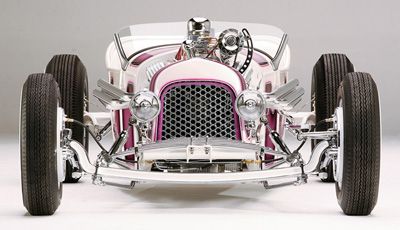
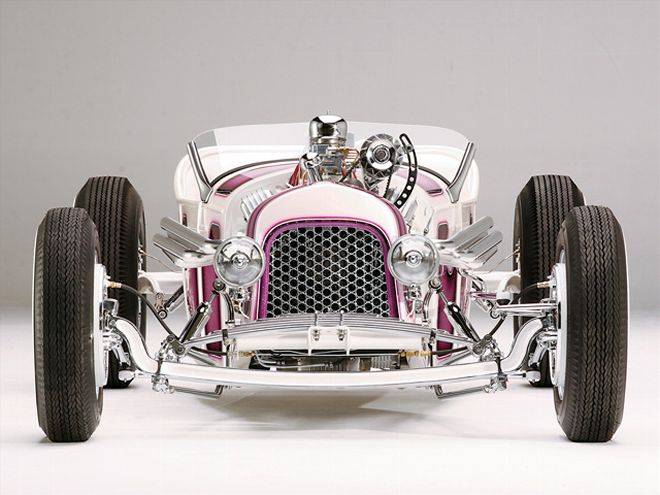
While not a high-profile item such as a Du Vall windshield or Halibrand quick-change, the dropped I-beam axle has been around hot rodding since the very beginning.
San Diegan Abe Kobeck is generally credited with the idea of reshaping the ends of a stock Ford I-beam and raising the kingpin bosses, which in turn lowers the car. Stock Ford axles, modified in such a way, could be seen on many hot rods right up to the end of the 1950s, with two of the most famous companies offering an axle-dropping service being Ed "Axle" Stewart's Dago concern in San Diego (Dago is a slang term, mainly used by Navy personnel, for San Diego), and John Moore's Mor-Drop in Oakland. The latter is still in existence, though Moore died in 1971, and while the company still drops axles, it concentrates on more regular automotive work these days.
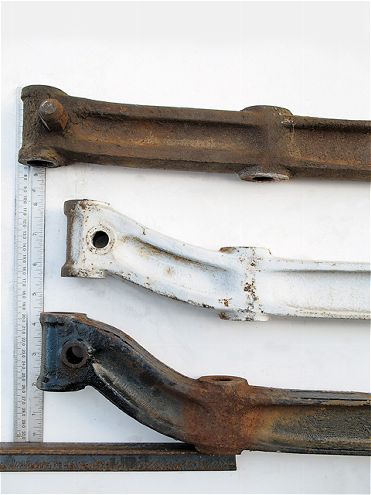 There are a couple of things to note here. First is how to measure axle drop. With a straight-edge placed across the flat of the perch boss on the '42-47 axle at the bottom of the picture, measuring up to the bottom of the kingpin boss reveals a drop of 2 inches. The '37-41 axle above has a drop of 1 1/4 inches and the Model A axle has zero drop. Secondly, these axles are all on the same centerline, so note the different widths, as well as the different distances between perch bosses. This means unless you split the wishbones, they'll only fit an axle from the same-year car. These were all found in my garage, and, unfortunately, I didn't have an early "heavy" '32 or '32-36 axle to show, but they both have similar lengths to the A axle between the perch and kingpin bosses, and it should be pretty obvious that these have more area to stretch and drop than the later axles.
There are a couple of things to note here. First is how to measure axle drop. With a straight-edge placed across the flat of the perch boss on the '42-47 axle at the bottom of the picture, measuring up to the bottom of the kingpin boss reveals a drop of 2 inches. The '37-41 axle above has a drop of 1 1/4 inches and the Model A axle has zero drop. Secondly, these axles are all on the same centerline, so note the different widths, as well as the different distances between perch bosses. This means unless you split the wishbones, they'll only fit an axle from the same-year car. These were all found in my garage, and, unfortunately, I didn't have an early "heavy" '32 or '32-36 axle to show, but they both have similar lengths to the A axle between the perch and kingpin bosses, and it should be pretty obvious that these have more area to stretch and drop than the later axles.
Dago has long ceased trading, though its axle-dropping jig apparently turned up a few miles north of San Diego in Escondido years later, but is now believed to be either lost or burned. Stewart's aggressive marketing, including selling the axles at the dry lakes race meets, ensured Dago axles became popular in Southern California.
By the end of the 1950s, however, having your stock axle dropped wasn't the only option, as the Bell dropped axle became available. It was a brand-new piece rather than a dropped stocker, but they're rare today, owing to their high price when new. Of course, Magnum, Chassis Engineering, Super Bell, Speedway, Total Cost Involved, and the latest entry, Borgeson, all followed with their own versions, in both I-beam and tube types, and varying amounts of drop, to the point that 5-inch dropped axles are now available, as well as aluminum and stainless steel axles.
That brings us to exactly how that drop is measured. If a straight-edge is placed against the bottom of the spring perch boss and extended out under the kingpin boss, the gap between the straight-edge and the bottom of that boss is the amount of drop the axle has. A Model A axle measures zero drop, whereas a '32 axle already has a 1-1/2-inch drop from the factory, so dropping this a further 2 1/2 inches results in the popular 4-inch dropped axle.
Obviously, there's a limit to how far a stock axle can be dropped, which is why axle selection is important if you're planning to have one done. More "meat" is available the farther the distance between the spring perch boss and the kingpin boss, as it's this section that is stretched. For this reason, the preferred axles are Model A, a '32 "heavy," or the '32-36 axle. A heavy '32 axle looks more like a truck axle because it is thicker, meaning the full height of the axle is as tall as the perch bosses (see the axle to the right).
All other early Ford axles see these bosses raised slightly above and below the upper and lower webbing. This also means the inset part of the axle-the part that is often drilled-is wider, or, more correctly, taller. The '37-41 axle is the narrowest of all overall, but all '37-and-later Ford axles have the perch boss close to the kingpin boss, offering good chances of tire interference should you run split wishbones or hairpins, even before it's dropped.
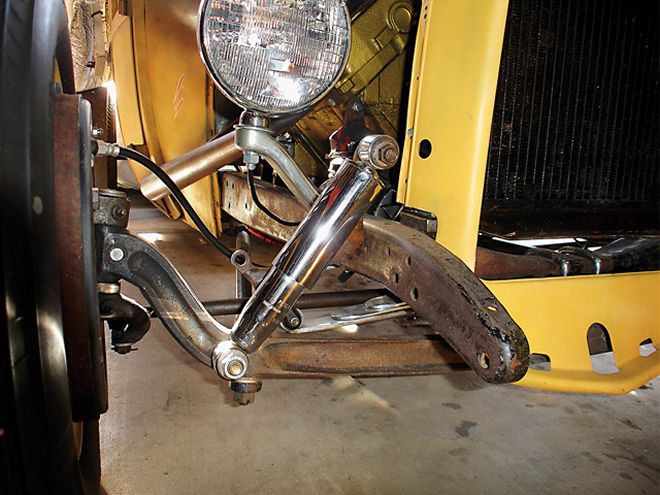 Note how uniform the curve is from the spring perch boss to the kingpin boss on this old Mor-Drop axle.
Note how uniform the curve is from the spring perch boss to the kingpin boss on this old Mor-Drop axle.
So, just how far can you drop an original axle? General consensus points to 3 1/2 to 4 inches on '28-36 axles, and 2 to 3 inches on anything later than 1937. Dave Mann of Roadsters.com says a 3-1/2-inch total drop on early axles provides a more aesthetically pleasing axle, as the radii of the bends at each end aren't as sharp as they'd be with another 1/2-inch of drop.
Companies like Industrial Chassis and Bear Metal Kustoms are dropping Ford axles right now, and making a beautiful job of it, too-and check out the polishing job available on dropped axles from Dave Mann; these axles look like stainless steel.
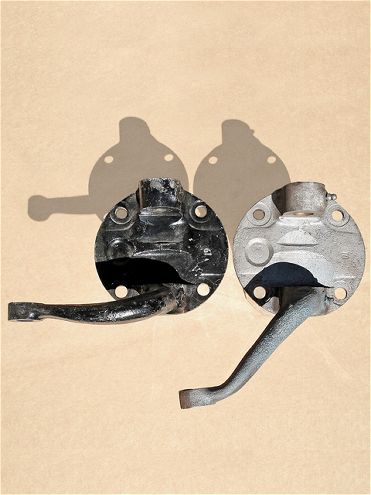 Dave Mann at Roadsters.com will only use original Ford axles, since, in his words, "They look right, and they don't break." Plus, they're forged, which is stronger than a casting. As can be seen from the picture above, he's also a master at polishing these axles, eliminating any waves or imperfections, and readying them for perfect chrome. This service costs extra, but it's definitely worth it. Note that the picture shows the same axle, before and after dropping. Dave's work is very sympathetic in its preservation of early Ford components, his approach being that if modified early parts are used, the finished car will appear more period correct, and to that end, he can also modify original Ford spindles so the steering arms work with his dropped axles, rather than resort to aftermarket spindles and steering arms. So, although aftermarket axle manufacturers offer spindles and steering arms, we're only showing these modified Ford versions here.
Dave Mann at Roadsters.com will only use original Ford axles, since, in his words, "They look right, and they don't break." Plus, they're forged, which is stronger than a casting. As can be seen from the picture above, he's also a master at polishing these axles, eliminating any waves or imperfections, and readying them for perfect chrome. This service costs extra, but it's definitely worth it. Note that the picture shows the same axle, before and after dropping. Dave's work is very sympathetic in its preservation of early Ford components, his approach being that if modified early parts are used, the finished car will appear more period correct, and to that end, he can also modify original Ford spindles so the steering arms work with his dropped axles, rather than resort to aftermarket spindles and steering arms. So, although aftermarket axle manufacturers offer spindles and steering arms, we're only showing these modified Ford versions here.
Fifty or more years ago, the quality of dropped axles varied considerably, which is why early Mor-Drop axles earned a good reputation; their modified ends showed a smooth transition from perch boss to kingpin. Some others were plain terrible, the upper and lower webbing on the axle becoming hideously distorted during less-than-perfect dropping techniques.
Some practitioners of the craft used heat, presses, and a jig to do the deed, while cruder operators used heat and a big hammer. Literally. Such axles were rarely pretty. Then there were dropped axles that had the ends filled once dropped. This essentially meant they were often ugly after the process, so the entire area between the bosses was filled with weld. Over time, this has come to be accepted as cool, but it was originally done to hide poor craftsmanship. It also adds rigidity to a component that was originally designed to flex as part of the suspension.
We should mention here that I-beam axles from manufacturers other than Ford can be dropped, too, but the labor-intensive and time-consuming jig manufacture often prohibits the financial practicality of a company offering such a service. Likewise, later Ford truck axles can be dropped. The great advantage of a dropped axle is that it lowers the car without sacrificing any suspension travel, unlike, say, reversing spring eyes or removing spring leaves, which can lead to the stock wishbone hitting the underside of the chassis 'rails in extreme cases. It also leaves the shock absorbers working as they should, whereas altering the suspension to bring the chassis closer to the axle will likely cause tube shocks to bottom out or lever-arm shocks to require shortened links.
If you're planning on having a stock axle dropped, or even using an aftermarket axle, there's a fair chance you're after a traditional look to the finished car, and you may be contemplating using a wishbone. If you're really going for an early look and don't want to split the 'bones, take care to select an axle and wishbone that will fit together if they didn't originally come from the same. A point to remember is that the spring perch bosses on Model A axles are 2 1/4 inches thick, as are '37-and-later, but '32-36 bosses come in at 2 inches, meaning you'll need to ensure your wishbone is the correct size for your axle.
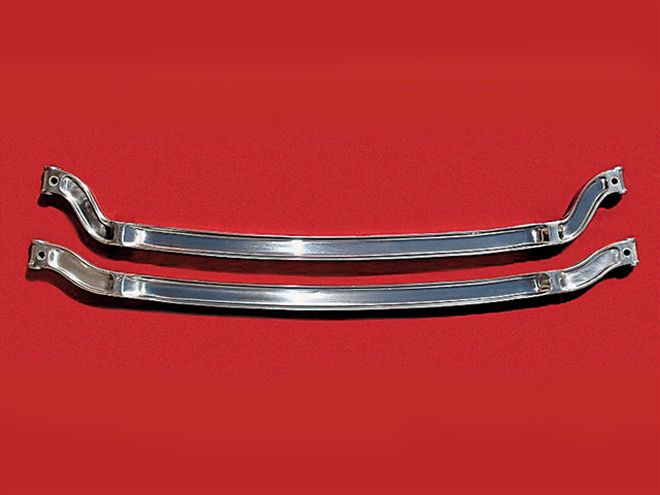
You can use a spacer if you're using an axle with 2-inch bosses, but you'll have to machine the wishbone and axle to make it fit if you have 2-1/4-inch bosses and a 2-inch wishbone. Of course, it may be easier to source another wishbone! Also, be aware that the later axles that place the spring in front, rather than above, are 2 inches wider between the spring-perch holes, meaning a longer spring (33 1/2 inches) is required if you want to run it above the axle. And, it takes a narrower spring than the 2-inch-wide later leaves if you're using a Model A crossmember.
This all makes axle selection sound confusing, but only if you're mixing and matching early Ford components. If you're using an aftermarket axle and hairpins, or even sourcing all your components from the same company, the only choices you should have to make are what finish you want the axle to have, how much drop, and how wide. The latter will be important if you're running a full-fendered car and want the tires tucked in, especially if it's low.